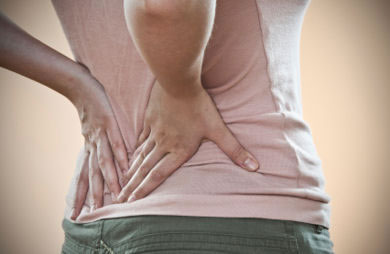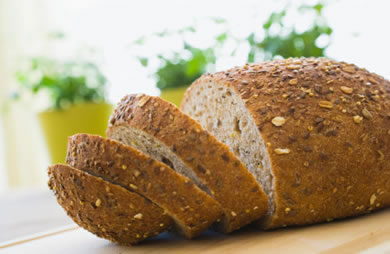What's Really Making Your Back Hurt?
6 Myths and Facts about Back Pain
-- Kathy Babcock
SparkPeople advertisers help keep the site free! Learn more

| This morning, you probably didn't think twice about slinging a work tote over your shoulder or picking your sneakers up off the floor. But there may come a time when one of those simple motions will trigger a backache bad enough to cause you to call in sick, see a doctor, or at the very least, take a few painkillers. According to the American Academy of Orthopaedic Surgeons, four out of five women will develop a back injury at some point in their lives. But with a few simple changes, you can prevent yourself from becoming a statistic. The trick, says Douglas Chang, M.D., chief of physical medicine and rehabilitation at the University of California, San DiegoMedical Center, is separating the misconceptions from the facts. We asked Chang and other experts to set the record straight on how to best prevent and heal aches and pains. MYTH #1 Lifting heavy objects will strain your back. FACT Most injuries are caused not by what you pick up, but how you do it. The proper form: Squat, keeping your back straight. Grab the object, bring it close to your body, then stand; your thigh and butt muscles should do the lifting. Just grabbing a pen off the floor? It's still important to be careful, because simply twisting the wrong way can harm your back. "One of the worst moves is bending over to the side while staying seated with your feet planted on the floor," says Rahul Shah, M.D., an orthopedic spine surgeon in Winter Park, Florida. "Twisting your back in two directions at once may strain the disks that cushion your spinal vertebrae." This repetitive trauma builds up over the years and can weaken your spine. "If your back is already vulnerable," says Shah, "the wrong movement could easily trigger an injury." MYTH #2 Sitting up straight keeps your spine in line. FACT While your mom was right to stop you from hunching, holding yourself too erectly isn't as good for your back as you think. "It puts a lot of stress on your disks, especially when you do it for long periods of time," says Santhosh Thomas, a doctor of osteopathic medicine and medical director of the Cleveland Clinic's Center for Spine Health in Westlake, Ohio. In fact, researchers at Woodend Hospital in Scotland found that people who sat at a 90-degree angle strained their spines more than those who reclined at 135 degrees. What's a woman to do? Adjust your posture a few times a day, recommends Shah. "Lean back in your chair with your feet on the ground and make sure there's a slight curve in your lower back." That way, he explains, you'll distribute your body weight more evenly, as your shoulders and upper back muscles will take some of the pressure off your spine. If you often find yourself slouching at your desk at the end of the workday, consider using a cushion to support your lower back and keep your spine in alignment. What may be even more important than sitting correctly is taking frequent breaks from your desk throughout the day. To boost circulation in your back muscles and lessen fatigue, stand up every half hour and take a five-minute stroll or stretch every hour. Do some of your work while standing up to give your spine a little reprieve. Take a phone call on your feet, or place a report on top of a waist-high filing cabinet so you can stand and read it. MYTH #3 Most exercise is hard on your back. FACT Researchers from Samsung Medical Center in Korea found that working out at least three times a week actually reduced the risk for developing chronic back pain by 43 percent. Exercise strengthens your back muscles and increases blood flow to the disks, helping them withstand daily strain. Hitting the gym regularly also keeps your waistline in check, which has a huge payoff for your back: A study in the journal Spine revealed that overweight people were nearly three times as likely to go to the hospital with a back injury than those at a healthy weight. Even as little as 5 or 10 extra pounds can put stress on your spine, increasing your risk of injury. Opt for low-impact aerobic exercise, such as walking, swimming, or using the elliptical machine, to strengthen your back without putting excess pressure on your disks or joints. Still, it's important not to do too much. Overexerting yourself—by lifting too-heavy weights or stretching past the point of comfort—is a surefire way to injure your back. To protect yourself while working out: Warm up with at least 15 minutes of light cardio to increase blood flow to back muscles. Next, observe your form in the mirror when lifting weights. Your back should always be straight, whether you're working your biceps or your legs. Finally, avoid overstretching or bouncing; those movements jar the spine and muscles. MYTH #4 Back pain is always caused by an injury. FACT Between juggling a huge work deadline and planning your sister's bridal shower, taking a time-out may seem like a luxury. But when it comes to caring for your back, it's essential. According to a study in the Journal of Advanced Nursing, women who feel overwhelmed at home or work are more than twice as likely as their calmer counterparts to have lower back pain. "Mental stress causes the smallest units of the muscle, the fibers, to tighten," says Ulf Lundberg, Ph.D., a professor of biological psychology at Sweden's Stockholm University. Over time, clenched muscle fibers wear down, upping the risk for injury. And to make matters worse, your body's natural response—an increase in muscle tension—can aggravate existing back problems. So the next time you feel the pressure rising, make a point to work at least half an hour of relaxation into your day no matter how frenzied you feel. A hot bath or shower is one of the best ways to decompress, because heat can relax your back muscle fibers. To boost the benefits even more, use lavender-scented bath beads or soap: In a Japanese study, people who sniffed the calming scent had lower levels of the stress hormone cortisol. Your back already in knots? Get a massage. Find a massage therapist near you through the American Massage TherapyAssociation. MYTH #5 Alternative treatments don't work. FACT Nearly one in six Americans has tried some form of alternative therapy to ease an aching back, according to the National Institutes of Health. And for good reason: Studies suggest these treatments may be more effective than conventional physical therapy and medications in some cases. In fact, in a recent German study, half of the lower back patients who received two weekly acupuncture sessions over six months reported a significant reduction in pain. The needles may stimulate the release of pain-relieving brain chemicals, say experts. Find a licensed practitioner from the American Association of Acupuncture and Oriental Medicine. Research also shows that seeing a chiropractor may help you feel better faster. These practitioners believe back pain is caused by dislocations in the vertebrae. During an "adjustment," gentle force is applied to your spine to stretch your joints and realign them. To find a licensed chiropractor near you, consult the American Chiropractic Association. MYTH #6 A super firm mattress is best for your back. FACT Actually, it might be the source of your pain. Trying to find a back-friendly bed is like playing Goldilocks: A too-soft mattress doesn't offer enough support, while a rock-hard one can increase pressure on the spine. A study in the journal Lancet found that those who snoozed on a medium-firm mattress experienced less back pain—and popped fewer pain relievers—than those who slept on a harder one. Can't afford a brand-new bed? Consider buying a pad such as those from Therapedic (from $30; bedbathbeyond.com) to cushion an extra-firm mattress. If your bed is too soft, place a bed board, like one by Duro-Med ($35; drugstore.com), beneath the mattress to prevent it from sagging. |





